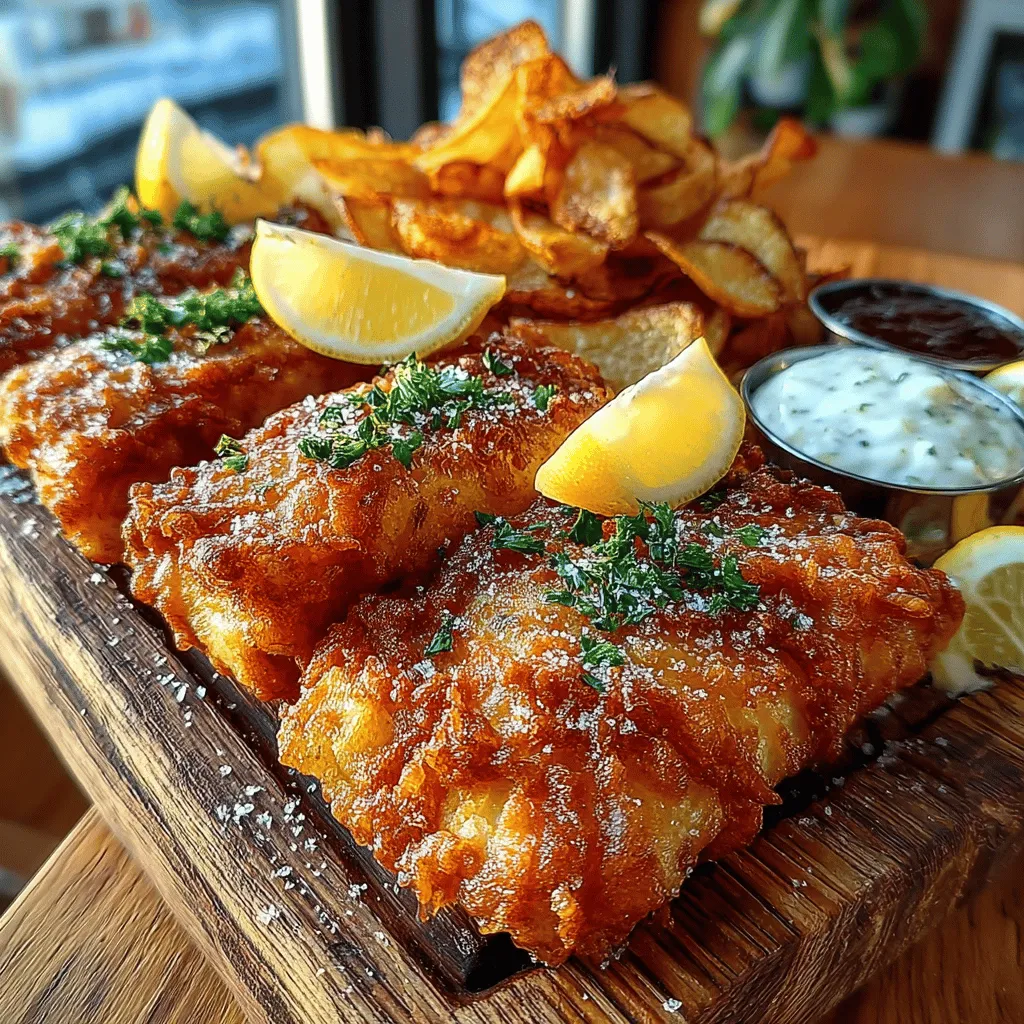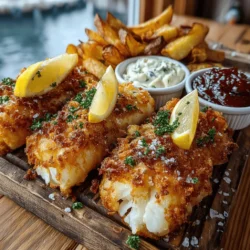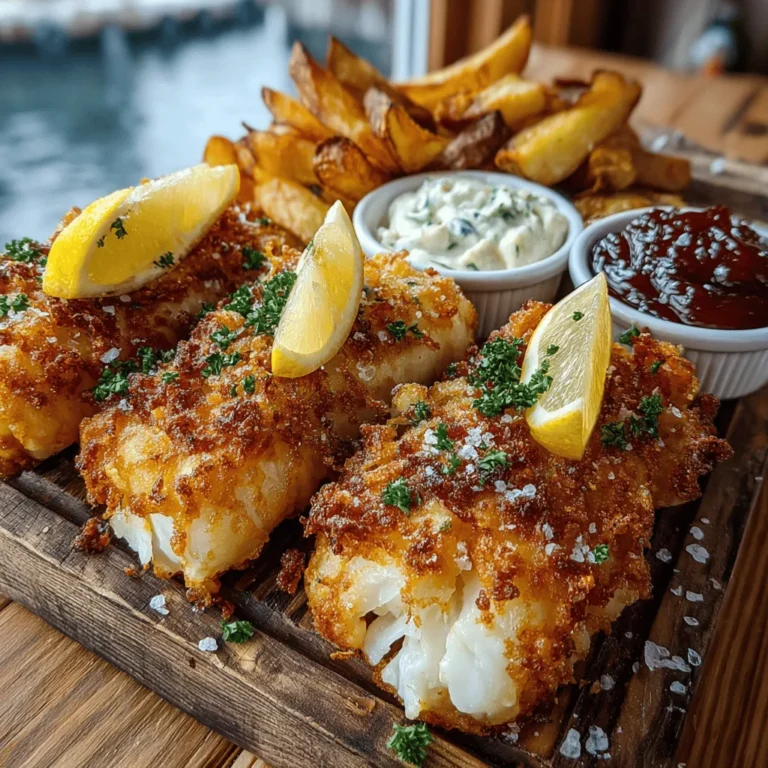Crispy Ocean Delight: Golden Fried Fish & Chips
Introduction
Fish and chips is more than just a meal; it’s a culinary tradition that has captured the hearts and taste buds of people across the globe. This classic dish, originating from the United Kingdom, has become synonymous with comfort food, offering a delightful combination of crispy battered fish and fluffy, golden chips. The popularity of fish and chips can be attributed to its simple yet satisfying flavors, making it a go-to option for both casual diners and gourmet restaurant menus.
In this article, we will delve into a delightful recipe called “Crispy Ocean Delight,” which showcases a perfectly crispy texture and uses only the freshest ingredients. The essence of this dish lies in selecting high-quality fish and achieving the perfect fry on the chips, ensuring an authentic taste that pays homage to its British roots.
The Appeal of Fish and Chips
The history of fish and chips dates back to the 19th century when the dish emerged as a staple in working-class Britain. It is believed that the practice of frying fish in batter was brought to England by Jewish immigrants from Portugal, while the idea of frying potatoes became popular in the same period. The combination quickly gained traction, and by the late 19th century, fish and chips shops began to open across the country, providing affordable meals for the masses.
Over the years, this dish has evolved, with numerous regional variations arising. In the UK, you might find a variety of fish such as cod, haddock, or even plaice, while other countries have embraced their own local fish varieties. The global influence of fish and chips can be seen in places like Australia, where it is often served with a side of tartar sauce and lemon, and in parts of Canada, where it is paired with malt vinegar. The versatility and universal appeal of fish and chips have made it a beloved dish in many cultures, from seaside fish shacks to upscale dining establishments.
So why does fish and chips remain a favorite for so many? It’s the combination of textures and flavors—the crunch of the batter, the flakiness of the fish, and the soft, warm chips that all come together to create a satisfying dish that is perfect for any occasion. Whether enjoyed as a casual takeaway meal or as part of a family gathering, fish and chips evoke a sense of nostalgia and comfort that few other dishes can match.
Ingredients Breakdown
To prepare the perfect fish and chips, it’s essential to start with high-quality ingredients. Here’s a breakdown of the main components of our “Crispy Ocean Delight” recipe.
1. Fish: The star of the dish is undoubtedly the fish, and for this recipe, we recommend using flaky white fish varieties such as cod, haddock, or tilapia. Cod is particularly popular for its mild flavor and firm texture, making it ideal for frying. Haddock, with its slightly sweeter taste, is another excellent choice, while tilapia offers a budget-friendly option without compromising on taste.
2. Flours: The choice of flour can significantly impact the texture of your batter. For a classic fish and chips batter, all-purpose flour is commonly used, providing a good balance of structure and crispiness. However, for an extra crunch, mixing in rice flour can elevate the texture, creating a light and airy batter that fries up beautifully. This combination not only enhances the crispiness but also reduces the heaviness often associated with traditional batters.
3. Seasoning: Seasoning is crucial for ensuring that the fish and chips are flavorful. The batter should be lightly seasoned with salt and pepper, while the chips can benefit from a sprinkle of sea salt after frying. You may also consider adding spices like paprika or garlic powder to the batter for an extra kick.
4. Optional Serving Suggestions: Traditional accompaniments for fish and chips include malt vinegar, which adds a tangy flavor, and tartar sauce, a creamy blend of mayonnaise, pickles, and herbs that complements the fried fish perfectly. You can also serve your dish with lemon wedges for a fresh burst of acidity.
Preparation Steps for the Perfect Chips
Now that we have an understanding of the essential ingredients, let’s focus on preparing the perfect chips, which are just as important as the fish in this dish.
1. Choosing the Potatoes: The best type of potato for making chips is the russet potato, known for its starchy content and ability to crisp up beautifully when fried. Start by selecting large, firm russet potatoes that are free from blemishes.
2. Cutting the Chips: Begin by peeling the potatoes, then cut them into even-sized strips, about 1/4 to 1/2 inch thick. Uniformity in size ensures that the chips cook evenly, giving you that perfect crispy exterior and fluffy interior.
3. Soaking the Potatoes: One crucial step that many home cooks overlook is soaking the cut potatoes in cold water for at least 30 minutes, or ideally, overnight. This soaking process helps to remove excess starch from the potatoes, which is key for achieving the ultimate crispiness. By removing the starch, you prevent the chips from sticking together and ensure they fry up light and crunchy.
4. Drying the Chips: After soaking, drain the potatoes and pat them dry with a clean kitchen towel or paper towels. Removing any excess moisture is essential; if the potatoes are wet when they hit the hot oil, they will steam instead of fry, resulting in soggy chips.
5. Blanching the Chips: For the best texture, consider blanching your chips in hot oil before the final fry. Heat a deep pot with oil to around 300°F (150°C) and carefully add the dried potato strips in batches. Fry them for about 5-6 minutes until they are soft but not browned. Remove them from the oil and let them drain on paper towels. This step helps to cook the potatoes through without achieving a full crisp, setting the stage for the final fry.
With these preparation steps in place, you are well on your way to creating an extraordinary fish and chips experience that highlights the freshness of the fish and the delightful crunch of the chips. In the upcoming sections, we will explore the essential steps for preparing the fish, making the batter, and perfecting the frying technique, ensuring that your “Crispy Ocean Delight” lives up to its name.

Baking Perfect Chips
To complement your crispy fried fish, the perfect chips are essential. Baking chips can yield a healthier option while still satisfying that craving for crunch. Follow these steps to achieve perfectly golden brown chips.
Step-by-Step Guide for Baking Chips
1. Preheat the Oven: Set your oven to 425°F (220°C). This high temperature is crucial for achieving that desired crispiness.
2. Prepare the Potatoes: Use starchy potatoes like Russets or Maris Piper, as they yield the best results. Wash and peel the potatoes before cutting them into thick, even sticks. Aim for uniformity to ensure even cooking.
3. Soak the Potatoes: Soak the cut potatoes in cold water for at least 30 minutes. This step removes excess starch, which helps in achieving a crispier texture once baked.
4. Dry the Potatoes: After soaking, drain and rinse the potatoes. Pat them dry thoroughly using a clean kitchen towel. Removing moisture is key to getting that golden brown finish.
5. Season and Coat: In a large bowl, toss the dried potato sticks with olive oil, salt, and any other desired seasonings such as garlic powder or paprika. A light coating of oil will help them crisp up beautifully in the oven.
6. Spread on a Baking Sheet: Arrange the potatoes in a single layer on a baking sheet lined with parchment paper. Make sure they are not overcrowded, as this will steam the potatoes instead of baking them.
7. Bake: Place the baking sheet in the preheated oven. Bake for 25-30 minutes, turning the chips halfway through to ensure even browning. Keep an eye on them toward the end of the cooking time to prevent burning.
8. Achieving Golden Brown Color: For the perfect golden color, look for a deep golden hue on the chips. If they are not quite there, give them an extra few minutes in the oven but watch closely to avoid overcooking.
Crafting the Ultimate Batter for Fish
The secret to a delightful fish fry lies in the batter. A well-crafted batter not only adheres perfectly to the fish but also provides that light and crispy coating that makes every bite irresistible.
Ingredients for the Batter
– All-Purpose Flour: This forms the base of your batter, providing structure.
– Cornstarch: Adding cornstarch increases the crispiness of the batter.
– Baking Powder: A leavening agent that helps the batter puff up and become light.
– Salt: Enhances flavor.
– Cold Sparkling Water: The key ingredient for a light and airy texture.
Step-by-Step Instructions for Mixing the Batter
1. Combine Dry Ingredients: In a large mixing bowl, whisk together 1 cup of all-purpose flour, 1/2 cup of cornstarch, 1 teaspoon of baking powder, and 1 teaspoon of salt until well combined.
2. Add Sparkling Water: Gradually pour in 1 cup of cold sparkling water while whisking continuously. The cold temperature is essential for a light batter, as it prevents gluten development, keeping it airy.
3. Check Consistency: The batter should be thick enough to coat the back of a spoon but still pourable. If it’s too thick, add a splash more sparkling water. If too thin, sprinkle in a bit more flour.
4. Rest the Batter: Let the batter sit for about 10-15 minutes. This resting period helps the flour hydrate, resulting in a smoother batter.
Frying Techniques for Perfectly Crispy Fish
The frying process is the final step that transforms your marinated fish into a crispy delight. Follow these techniques to ensure your fish comes out perfectly every time.
Preparing Fish Fillets for Frying
1. Choose the Right Fish: Opt for firm, white fish like cod, haddock, or pollock. These varieties hold up well during frying.
2. Pat Dry: Use paper towels to pat the fish fillets dry thoroughly. Removing moisture is crucial for achieving a crispy coating.
3. Dredging Technique: Lightly coat each fillet in all-purpose flour before dipping into the batter. This creates a dry surface that helps the batter adhere better.
Frying Method: Deep Frying vs. Pan Frying
– Deep Frying: This method allows for even cooking and a consistent golden color. Fill a deep pot or fryer with oil to a depth of about 3 inches and heat to 350°F (175°C).
– Pan Frying: For a slightly lighter option, use a large skillet with enough oil to reach about 1 inch in depth. Heat the oil to the same temperature as deep frying.
Step-by-Step Guide to Frying Fish
1. Heat the Oil: Use a thermometer to ensure the oil reaches the correct temperature. If the oil is not hot enough, the fish will absorb too much oil and become greasy.
2. Fry in Batches: Carefully place the dredged and battered fish fillets into the hot oil. Avoid overcrowding the pan, as this will lower the oil temperature and lead to uneven cooking.
3. Time the Frying: Fry each fillet for about 4-5 minutes, depending on thickness. The fish should be golden brown and float to the top when done.
4. Check for Doneness: Use a slotted spoon to remove the fish and place it on a plate lined with paper towels to absorb excess oil. The fish should be crispy on the outside and flaky on the inside.
5. Maintain Oil Temperature: Check the oil temperature between batches. If it drops too low, allow it to heat back up before adding more fish.
Serving Suggestions and Pairings
Now that your crispy fish and chips are ready, it’s time to think about presentation and accompaniments that elevate the meal.
Presentation Tips
– Plating: Serve the golden fish and chips on a large platter or individual plates. Arrange the chips in a mound, with the fish placed on top or beside them for a rustic feel.
– Garnish: Fresh lemon wedges and chopped parsley can add a vibrant touch to your presentation. A sprinkle of sea salt can also enhance the visual appeal.
Complementary Side Dishes
– Coleslaw: A crunchy coleslaw provides a refreshing contrast to the rich fish and chips.
– Garden Salad: A light garden salad with a vinaigrette dressing can balance the meal and add freshness.
– Mushy Peas: A traditional British pairing, mushy peas offer a creamy texture that complements the crispy fish.
Condiments to Enhance the Flavor
– Tartar Sauce: A classic accompaniment, tartar sauce adds a creamy, tangy flavor that pairs beautifully with fried fish.
– Malt Vinegar: Drizzling a bit of malt vinegar over your fish and chips is a traditional British touch that adds acidity and enhances the flavors.
– Ketchup: For those who prefer a sweeter option, ketchup is a beloved condiment for chips.
Conclusion
Making homemade fish and chips is a rewarding experience that brings the joy of classic comfort food to your kitchen. With a perfectly crispy batter enveloping flaky fish and golden, baked chips, this dish is a celebration of flavors and textures. The satisfaction of crafting each component from scratch elevates the dining experience, making it a perfect meal for family gatherings or casual dinners.
The timeless nature of fish and chips continues to unite people around the table, evoking nostalgia and warmth. Whether you’re enjoying it on a rainy day or serving it at a festive gathering, this dish is sure to please. So gather your ingredients, follow these steps, and embark on a culinary adventure that will delight your taste buds and create lasting memories. Enjoy the delicious result of your efforts and share the joy of homemade fish and chips with family and friends!


